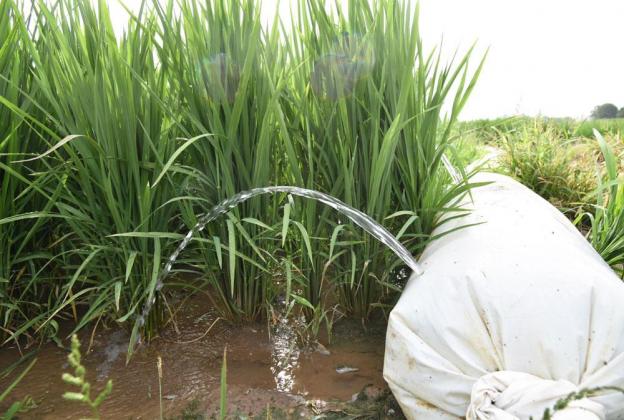
Farmers heard about the benefits and challenges of growing furrow-irrigated rice at an LSU AgCenter row rice field day on July 18.
The event was held at the Elliot Colvin Farm near Rayville, where the LSU AgCenter has one of three research fields in a project funded by the Louisiana Rice Research Board. The other two sites are in Tensas and Morehouse parishes.
Keith Collins, AgCenter agent in Richland Parish, estimated that about 10 percent of the 60,000 acres of rice grown in northeast Louisiana use this practice.
Furrow-irrigated rice, or row rice, involves irrigating a rice field only when the soil becomes dry, instead of maintaining a continuous flood through a growing season.
Moisture sensors in the middle of the research fields can be monitored by computer or smartphone to help determine when a field needs to be irrigated. The sensors cost about $1,700, but they are not essential for using the growing method, Collins said.
The 23-acre research field was planted with a drill on May 5 and 6. “We got a perfect stand,” he said.
AgCenter rice specialist Dustin Harrell said the furrow-irrigated option allows farmers to grow rice on ground traditionally not used for rice because of elevation differences.
The method gives farmers the advantage of waiting to see how commodity prices are moving before deciding what to plant. If rice is showing the best return, a row-rice crop can be planted in a field where levees will not have to be prepared, Harrell said.
A furrow-irrigated crop can use less water than a field with a continuous flood.
With no flood covering a field, weed control is more of a challenge. Disease potential is higher, with a high probability for blast disease that thrives in dry conditions, Harrell said. Planting a hybrid is recommended because of its disease resistance.
He is working on fertilizer recommendations for row rice, and spectral imaging cameras are being used to help determine fertilizer amounts and timing.
High night temperatures are stressful for rice plants in the pollination phase, and low temperatures are forecast to be above 80 degrees in northeast Louisiana, which would be excessive for rice, Harrell said.
Rice is reaching a critical stage that requires water. “Keep that field moist during flowering and grain filling,” he said.
Most rice in northeast Louisiana is heading, so scouting should be done for stink bugs.
AgCenter plant pathologist Don Groth said disease has been light this year. Most calls about diseases originate with fields of rice varieties that have higher disease susceptibility.
Scouting is necessary to find sheath blight early. “You want to catch that disease in the lower canopy,” he said.
A new fungicide, Amistar Top, is effective on fungicide-resistant sheath blight, but it doesn’t appear the material is working as well in the field as it did last year in demonstration plots, Groth said. It’s likely that Amistar Top needs to be applied earlier, before the boot or heading stages.
Steve Crawford, retired LSU weed scientist and now a crop consultant, said fields have to be weed-free before planting. Crabgrass and johnsongrass are big problems on fields he monitors.
A row-rice crop is given three fertilizer applications of about 100 pounds each time, or about 40 pounds more than a conventionally flooded crop, he said.
AgCenter entomologist Sebe Brown said weed control on the edges of fields will help control stink bugs.
Brown also said this year’s cold winter had an effect on insects that feed on soybeans. He said he received his first red-banded stink bug cast last week, compared to last year when he had numerous calls. Several new products have potential for controlling stink bugs.
AgCenter soybean specialist Todd Spivey said the state has roughly 1.4 million acres in soybeans. Much of the crop is in the critical pod filling stage, and many areas are in a drought condition.
AgCenter plant pathologist Boyd Padgett said he is telling most soybean farmers that fungicides aren’t needed on their crop because of light disease pressure. Effective spraying for Cercospora leaf blight requires an application of fungicide that places the material under the canopy.
